Commercial geranium farming is an attractive agricultural venture due to the increasing demand for geranium oil and flowers in various industries such as perfumery, pharmaceuticals, and cosmetics. A comprehensive geranium farming project report is essential to navigate the stages of setting up and running a successful farm.
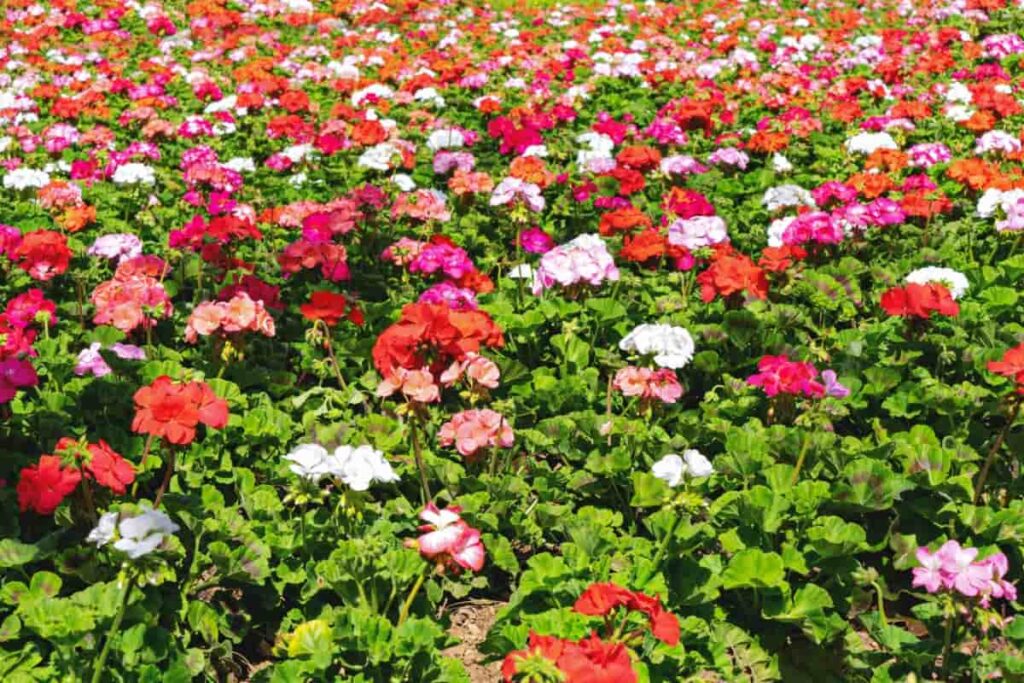
Key components of the report should include a detailed commercial geranium farming business plan, cultivation cost, and profit per acre. This plan should be meticulously crafted to cover all aspects, such as choosing the best varieties, understanding the optimal growing conditions, mastering propagation techniques, and exploring avenues like geranium farming subsidy and training programs to enhance the profitability and sustainability of the venture.
Commercial Geranium Farming
Best Geranium Varieties for Commercial Farming
Various geranium varieties flourish in different conditions and offer diverse benefits, aligning with specific market demands. Some popular varieties include the zonal geraniums, known for their adaptability and vibrant colors, making them ideal for ornamental purposes. With their trailing growth and lush foliage, Ivy geraniums are excellent for hanging baskets and decorative displays.
Scented geraniums captivate with aromatic leaves, finding a special place in essential oil extraction and aromatherapy. Choosing a mix of varieties can diversify the offering, appealing to different market segments and enhancing the farm’s resilience against fluctuating demands and climatic changes. Tailoring the selection of geranium varieties based on market research, environmental suitability, and cultivation goals is fundamental to the success of the commercial geranium farming endeavor.
Optimal Growing Conditions for Commercial Geranium Farming
Understanding and providing the optimal growing conditions are crucial for the success of commercial geranium farming. To thrive, geraniums require a delicate balance of sunlight, temperature, water, and soil fertility. They prefer well-drained soil with a slightly acidic to neutral pH.
Proper sunlight exposure is essential, as geraniums flourish in bright but indirect light. Temperature regulation is also crucial; moderate temperatures are ideal for robust growth. Adequate water supply without waterlogging the roots is necessary to maintain healthy plants. Knowledge of these growing conditions should be integral to the geranium farming project report to ensure a thriving and prosperous farm.
Geranium Propagation Techniques for Commercial Farms
For successful geranium cultivation, mastering propagation techniques is crucial. The propagation process involves creating new plants from the existing ones, ensuring the continuity and expansion of the farm. Various methods, such as seed sowing, cuttings, and division, are popular in geranium propagation. Seeds are readily available and can be a cost-effective method, but they require precise conditions for germination.
In case you missed it: How to Design a Balcony Garden for Year-round Harvests
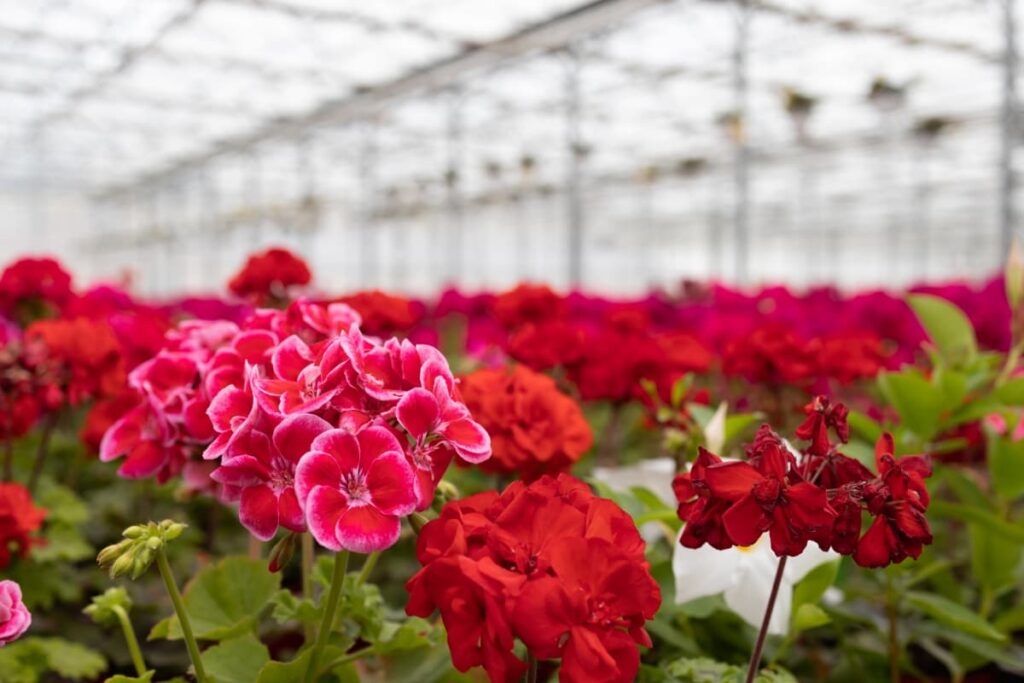
Cuttings and divisions allow for replicating the best plant traits and are common practices in commercial geranium farming. Adopting effective propagation techniques, possibly guided by insights from geranium farming training, can be pivotal in sustaining and scaling farming operations, contributing significantly to the cultivation cost and profit per acre. Additionally, exploring options like geranium farming subsidies can also be beneficial in offsetting some of the initial investment costs in propagation and other aspects of cultivation.
Geranium Planting and Spacing
Geranium planting and spacing are fundamental aspects that influence the growth and yield of the plants in commercial geranium farming. An appropriate planting density ensures that each geranium plant receives adequate sunlight, air, and nutrients to thrive. Generally, spacing about 12 to 24 inches between plants is advisable, depending on the variety and growth habit.
Furthermore, the rows should be about 18 to 36 inches apart, allowing easy accessibility during maintenance and harvesting. Proper spacing is crucial for healthy plant development, preventing overcrowding and minimizing competition for essential resources, thus contributing positively to the overall yield and success of the farm.
Irrigation and Water Management in Commercial Geranium Farming
Effective irrigation and water management practices are vital in sustaining a thriving commercial geranium farming business. Geraniums require consistent moisture levels in the soil; hence, a well-planned irrigation system is indispensable. The frequency and amount of irrigation depend on the climate and soil type, with more frequent watering needed in warmer and drier conditions.
It’s crucial to avoid waterlogging to prevent root rot and other diseases. Utilizing methods such as drip irrigation can help maintain optimal soil moisture levels while conserving water. Proper water management not only ensures the healthy growth of geraniums but also influences the farm’s cultivation cost and profit margins.
Soil Preparation and Fertilization for Commercial Geranium Farms
The soil is the foundation of geranium cultivation, and its preparation and fertilization are paramount in commercial geranium farming. Start with a thorough soil analysis to understand its current state and nutrient composition. The ideal geranium soil should be well-draining with a slightly acidic to neutral pH. Incorporating organic matter or compost can enhance soil fertility and structure.
For fertilization, use a balanced fertilizer that provides essential nutrients like nitrogen, phosphorus, and potassium, ensuring the plants receive adequate nourishment for healthy growth and development. Tailoring the fertilization schedule and types based on the soil’s needs and plant growth stages can optimize the results and contribute to a flourishing geranium farm.
Pest and Disease Management in Commercial Geranium Farming
Effective pest and disease management strategies are indispensable for maintaining a healthy and productive commercial geranium farm. Regular monitoring and timely interventions can prevent significant damage and losses. Employing integrated pest management (IPM) approaches, such as using natural predators and biopesticides, can be beneficial.
In case you missed it: Crop Harvest Calendar for Connecticut (CT): Fruits and Vegetables Season by Month Chart
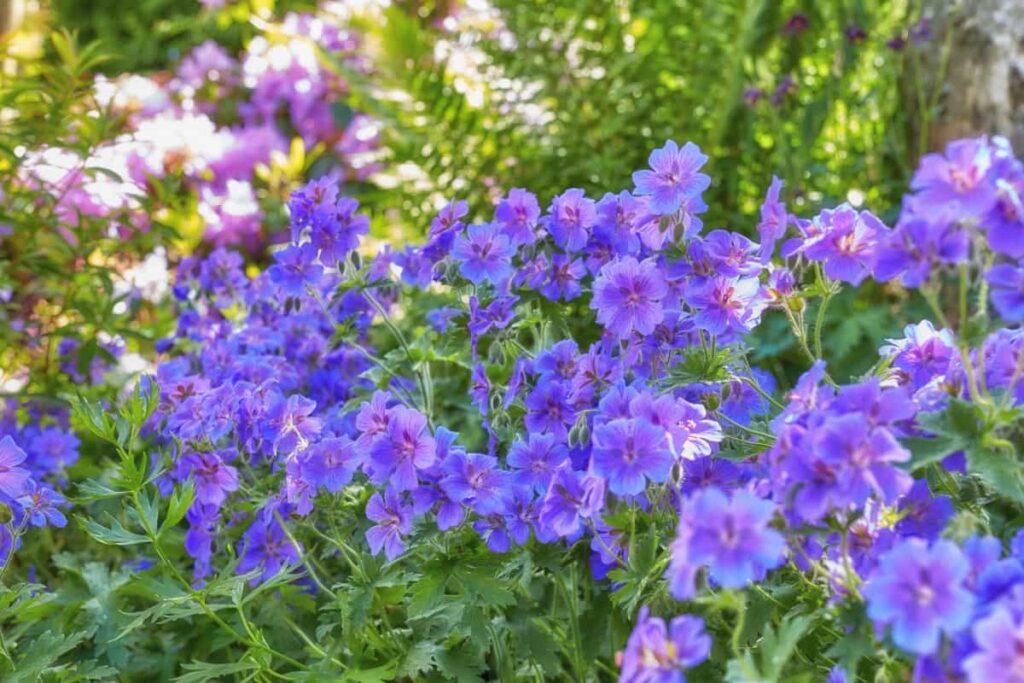
For disease prevention, ensure proper spacing adequate air circulation, and avoid waterlogging, which can create conducive environments for fungal diseases. Utilize appropriate fungicides and pesticides when necessary, always following recommended guidelines and practices. Comprehensive knowledge and proactive measures in pest and disease management are essential aspects that influence the geranium farming business’s overall success, cultivation cost, and profitability.
Harvesting and Post-Harvest Handling of Geranium Crops
Harvesting geraniums requires a careful approach, choosing the right time to ensure maximum oil content and flower quality. The best period for harvesting is usually in the morning hours when the plants are fresh and hydrated. After harvesting, proper post-harvest handling is crucial to maintain the quality of the flowers and leaves. This involves gentle handling, proper cleaning, and optimal storage conditions to prevent any loss of quality before they reach the market or undergo further processing.
Common Mistakes to Avoid in Geranium Farming
In geranium farming, common mistakes include improper spacing, inadequate watering, and neglecting pest and disease management. Avoid overcrowding plants as it hampers air circulation and light penetration, leading to a conducive environment for diseases. Ensure consistent and adequate watering without causing waterlogging. Stay vigilant about pests and diseases, implement preventive measures and timely interventions to maintain healthy plants, and avoid significant losses in yield and quality.
Business Plan for Commercial Geranium Farming
Creating a robust business plan for commercial geranium farming involves detailed planning and strategy. It should include clear objectives, market analysis, cost estimates, and revenue projections. Important considerations involve choosing the right variety, understanding cultivation practices, and planning for potential risks and challenges. A comprehensive business plan serves as a roadmap, guiding through various stages of the farming process, and is instrumental in achieving success and profitability in the commercial geranium farming venture.
Greenhouse vs. Open Field Cultivation of Geranium: Which is Better
Comparing greenhouse and open-field cultivation, each has its merits. Greenhouse cultivation allows for controlled environmental conditions, enhancing geranium growth and yielding higher outputs. It also protects against adverse weather conditions and pests. However, it involves higher initial investments. On the other hand, open-field cultivation is less costly but exposes plants to natural weather variations and pests. The choice between the two depends on financial considerations, climatic conditions, and specific goals of the geranium farming project.
In case you missed it: Plant Spacing Chart for Vegetables, Fruits, Flowers, Herbs and Calculate Ideal Plant Spacing
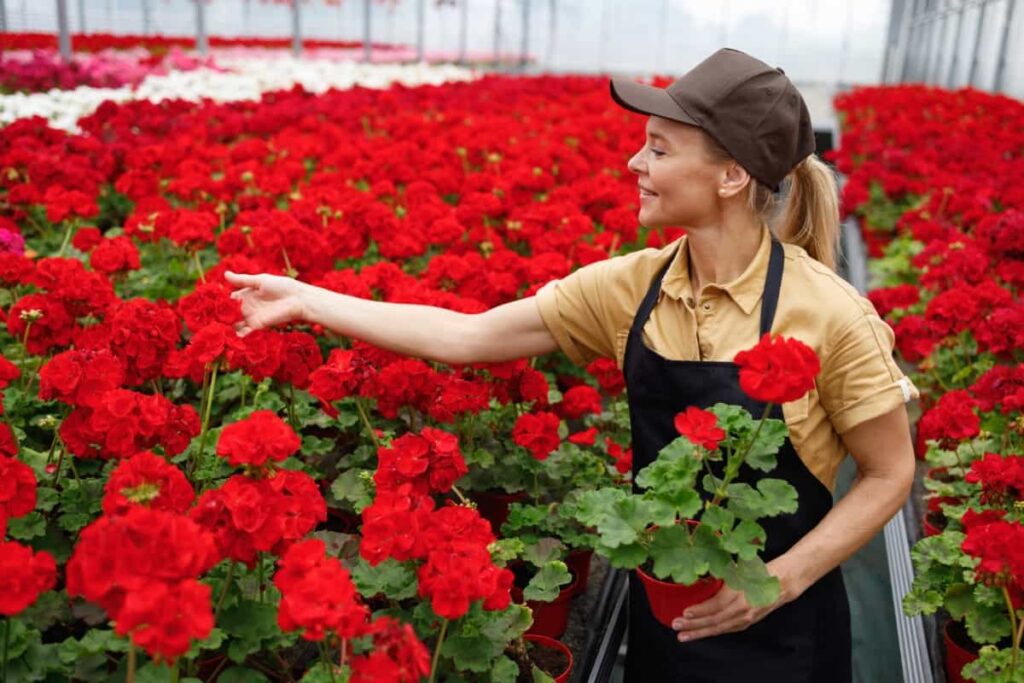
Geranium Essential Oil Extraction: Market Demand and Pricing
The extraction of geranium essential oil is a significant part of the value chain in commercial geranium farming. Due to its therapeutic properties and fragrant essence, this oil has carved a niche in various industries, such as cosmetics, aromatherapy, and pharmaceuticals. Understanding market demands and pricing strategies is crucial for maximizing profits in this segment. The market for geranium essential oil is influenced by factors such as quality, purity, and sustainable farming practices.
Prices can vary based on these factors, and a keen eye on market trends, competitor analysis, and consumer preferences is necessary for setting competitive prices that cover the cultivation cost and guarantee a good profit margin. Having a pulse on international markets can also be beneficial as it opens up broader avenues for selling geranium essential oil, allowing the farm to tap into a more extensive network of potential buyers and industries.
Marketing Strategies for Commercial Geranium Farms
Marketing strategies play a crucial role in the commercial success of geranium farms. Effective marketing involves identifying target markets, understanding customer needs, and positioning the products accordingly. Building a brand through unique selling propositions (USPs), such as quality, organic farming practices, or unique varieties, can enhance market presence. Digital marketing through websites and social media platforms can be instrumental in reaching a broader audience and engaging with customers directly.
Collaborations and partnerships with related businesses and industries, participating in agricultural fairs and expos, and utilizing online marketplaces can be harnessed to boost the market visibility and sales of geranium products. Ensuring that the marketing strategies are flexible and adaptable to market changes and trends is also essential for sustained success in commercial geranium farming.
Cost of Geranium Farming Per Acre
Investing in an acre of geranium farming involves various costs that collectively influence the venture’s overall profitability. Land preparation, which includes plowing and fertilizing, could cost around $100 to $200. The cost for high-quality seeds or seedlings may range between $300 and $500 per acre. Fertilizers and pesticides are recurring expenditures, and one might need to allocate about $200 to $400 per acre for them.
In case you missed it: 15 Gardening Mistakes to Avoid This Winter: For Vegetables, Flowers, Herbs, and Fruits
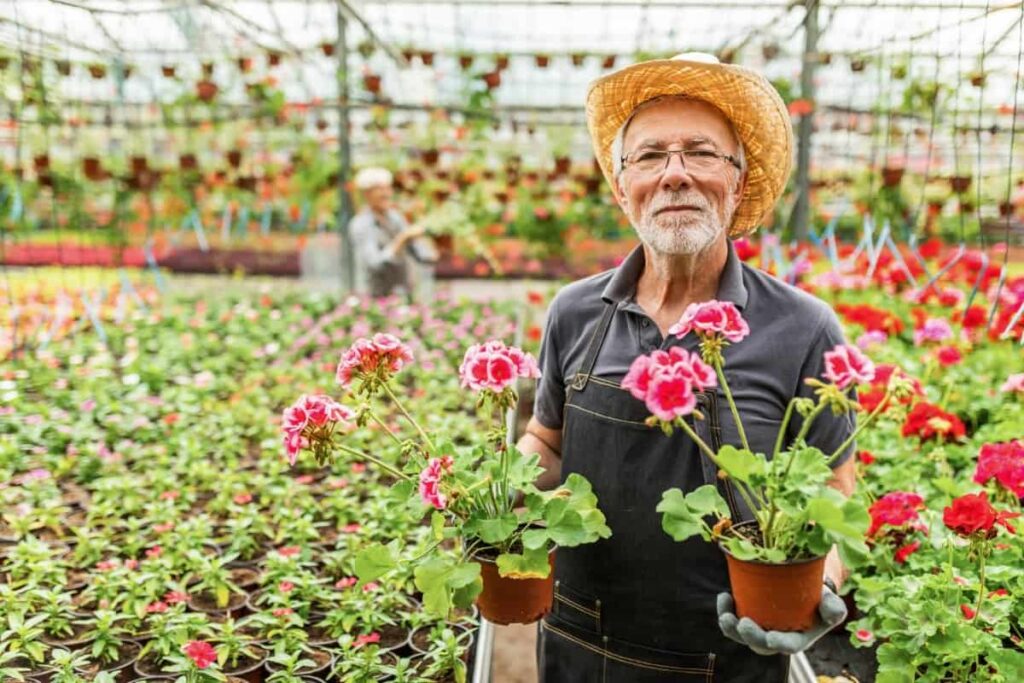
Essential for the geranium’s healthy growth, irrigation infrastructure could be established at an expense ranging from $100 to $300. Labor costs for tasks such as planting, nurturing, and harvesting the geraniums are substantial, potentially reaching up to $500 to $1000 per acre, based on the region and labor market. Additionally, miscellaneous expenses like equipment and machinery purchases or rentals, insurance, and other operational costs need allocation, which could sum up to around $200 to $500.
Profit in Commercial Geranium Farming Per Acre
Profitability in commercial geranium farming per acre is determined by the revenue generated minus the total cultivation costs. Revenue comes from selling geranium flowers, leaves, or essential oils and their respective market prices. Factors such as market demand, quality of the products, and effective marketing strategies significantly influence revenue.
Profitability can be maximized by optimizing cultivation practices to enhance yields, improving product quality, and utilizing effective marketing and sales strategies. Additionally, exploring opportunities like geranium farming subsidies and engaging in value-added activities like essential oil extraction can significantly enhance the profit margins of commercial geranium farming.
Government Regulations and Compliance in Commercial Geranium Farming
Government regulations and compliance standards in commercial geranium farming are pivotal areas that need meticulous attention. These regulations include land use, water resources, pesticides and fertilizers, labor laws, and quality standards. Adherence to legal requirements and industry best practices is essential for lawful operations and contributes to the farm’s credibility and reputation.
Understanding and keeping abreast of local, state, and federal laws, as well as industry certifications and accreditations, is crucial. Non-compliance can lead to legal repercussions and penalties, jeopardizing the business’s sustainability and success. Hence, a comprehensive understanding and diligent application of relevant regulations and standards are imperative in the operational framework of commercial geranium farming.
Frequently Asked Questions (FAQ) on Commercial Geranium Farming
Is Geranium Farming Profitable?
Yes, geranium farming can be profitable, primarily due to the high demand for geranium oil and flowers in various industries. Profitability depends on market demand, cultivation practices, and effective business strategies.
What is the Cost of Geranium Cultivation?
The geranium cultivation cost varies based on location, land preparation, seeds, fertilizers, pesticides, labor, and other operational expenses. A detailed budget planning is essential for accurately estimating the cultivation costs.
How Do I Start a Geranium Farm?
Starting a geranium farm involves careful planning, beginning with market research, selecting suitable land, choosing the right geranium varieties, and preparing a detailed business plan. Additionally, acquiring the necessary knowledge and resources for cultivation and market strategies is essential.
In case you missed it: Month-by-month Gardening in the Philippines for Vegetables and Flowers
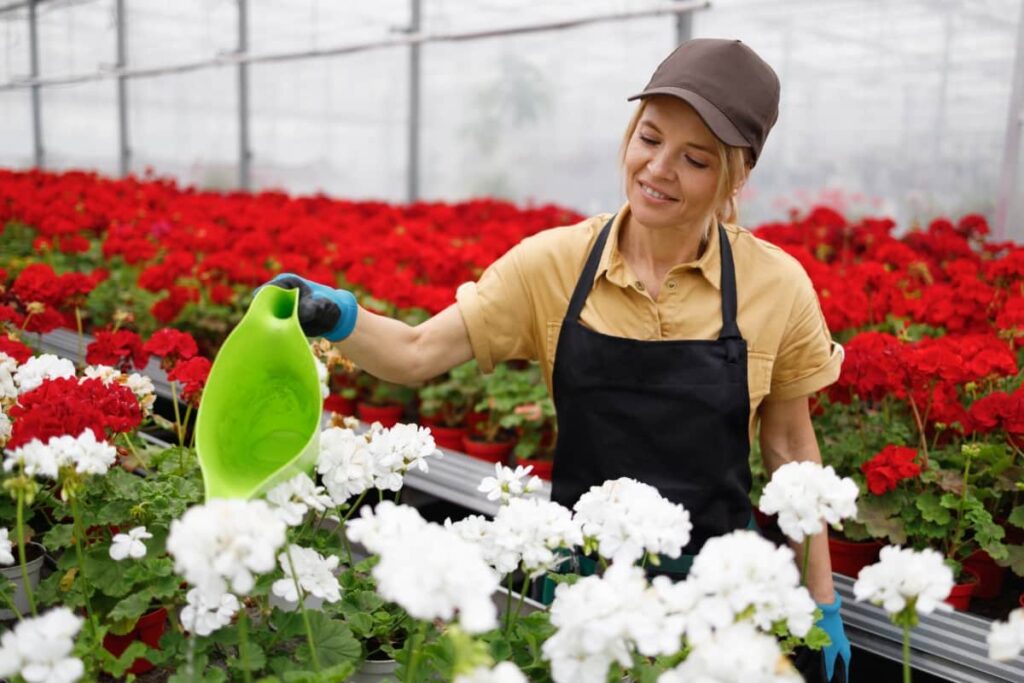
Conclusion
Commercial geranium farming presents a lucrative opportunity in agribusiness, characterized by cultivating these vibrant flowers for their aesthetic appeal and essential oil extraction. The journey from seedling to a flourishing geranium farm demands strategic planning, practical knowledge, and meticulous execution.
Essential considerations span from choosing appropriate varieties, optimizing cultivation practices, navigating market dynamics, and ensuring compliance with government regulations. Equipped with a robust business plan and a resilient approach, geranium farming can flourish, yielding substantial profits and establishing a sustainable and rewarding agricultural venture.
- Profitable Village Farming Business Ideas in 2024
- High-Yield Aquaculture: Fast-Growing Fish for Farming
- Effective Fish Pond Construction Techniques for Beginners
- Irrigation and Water Management in Pineapple Farming
- Blossom to Harvest: Mastering Flowering and Pollination in Papaya Farming
- Pig Fattening Essentials: From Selection to Sale for Beginners
- Raising Wagyu Cattle: A Complete Guide for Premium Beef Production
- Soil Types and Their Water Holding Capacity
- Optimizing Irrigation Schedules for Coconut Groves for Enhanced Yield
- Espresso Your Garden: Coffee Grounds for Healthier Acid-Loving Plants
- The Best Soil Mix for Snake Plants: How to Mix Your Own Snake Plant Soil
- Green Thumb Success: Expert Tips for Cultivating Greenhouse Beans All Year Round
- Bloom All Year Round: The Ultimate Guide to Indoor Hyacinth Care
- Eco-Friendly Gardening: How to Make Liquid Fertilizer from Kitchen Waste
- Ultimate Guide to Grow Anise in Pots: Explore Seed Propagation to Harvesting
- Guide to Raising Chester White Pigs: Discover Breed Facts to Growth Management
- Mastering the Elegance: The Ultimate Guide to Weeping Cherry Tree Care, Planting, and Maintenance
- Ultimate Guide to Planting Garlic in Grow Bags: Growing Strategies for Beginners
- How to Fix Spider Plant Leaf-Related Problems: Natural and Organic Remedies
- 10 Reasons Why Your Tulsi Plant is Shedding Leaves: Home Remedies and Solutions
- Optimizing Growth and Yield: The Advantages of Palm Bunch Ash Fertilizer
- Utilizing Neem Oil Extract as a Natural Pesticide for Hydrangea
- From Soil to Harvest: Various Ways in Which Farmers Can Use AI Tools
- Steps to Encourage and Induce Citrus Flowers: A Comprehensive Guide
- How to Fix Snake Plant Leaf-Related Issues: Natural and Organic Remedies
- Transform Your Garden into a Fragrant Oasis with Raat Ki Rani (Night Blooming Jasmine)
- Discover the Ideal Chicken Breeds for Philippine Farms
- How to Create a Poultry Egg Farm Business Plan for Profits
- Grow Lemon Cucumbers Like a Pro: Insider Techniques for Bountiful Yields
- Ultimate Guide to Caring for Your Pink Princess Philodendron: Tips for Thriving Variegation
- Areca Nut Profit Per Acre: Calculating Yield and Cost of Cultivation
- How Kaveri Chicken is Becoming a More Profitable Breed in Indian Backyards
- Transform Your Barn: 9 Steps to Convert a Horse Stall into a Chicken Coop
- Exploring Suffolk Sheep Disadvantages with Limitations and Challenges
- Guide to Solving Potted Lemon Tree Problems: How to Revive Lemon Tree in Containers
- Steps to Encourage Female Pumpkin Flowers: Best Strategies for More Flowers and High Yields
